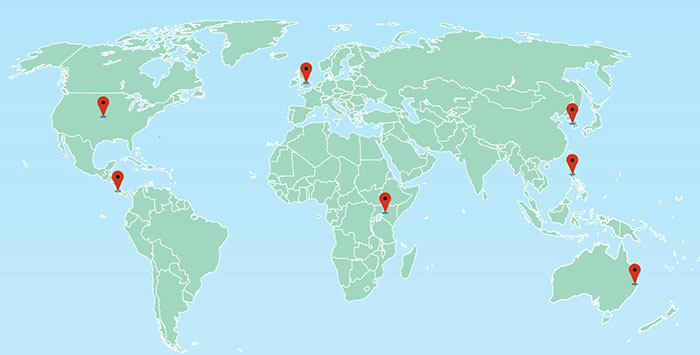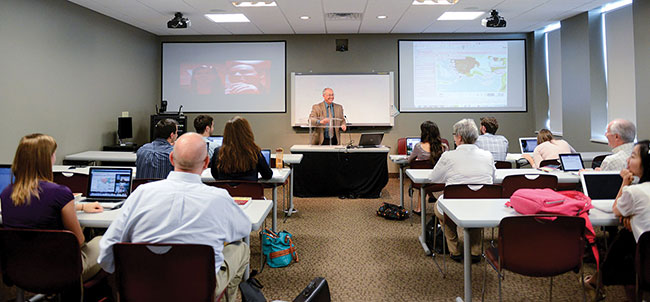
Recently I heard that Nazarene Theological Seminary was teaching classes in Kansas City using faculty from Nazarene schools in other countries. Wanting to know how this works, I called the seminary to talk to the president and the dean. They explained not just the technology, but also how the Church of the Nazarene is creating a global community of scholars.
Dr. Carla Sunberg was president of Nazarene Theological Seminary from 2014 until earlier this year, when she stepped down after being elected one of six general superintendents of the worldwide Church of the Nazarene. Dr. Josh Sweeden, who formerly taught at George Fox Evangelical Seminary, is the new dean of the faculty at Nazarene Theological Seminary.
Q How many seminaries does the Nazarene Church have around the world?
Carla Sunberg, president, Nazarene Theological Seminary: The Church of the Nazarene has more than 50 institutions of higher education globally. Seven of those are part of a consortium of graduate schools of theology.
-
Africa Nazarene University in Kenya.
-
Asia-Pacific Nazarene Theological Seminary in the Philippines.
-
Korea Nazarene University in South Korea.
-
Nazarene Theological College in Australia.
-
Nazarene Theological College in England.
-
Nazarene Theological Seminary in Kansas City, Missouri.
-
Seminario Nazareno de las Américas (SENDAS) in Costa Rica.
Josh Sweeden, dean of the faculty: We are a regional seminary serving a global church. That requires that we think about a broader constituency of students, as well as their learning needs, which is part of the reason we’re always interested in having a diverse faculty from various regions who have different cultural perspectives.
Q What makes you a consortium? What do you do together?
Sunberg: We’ve been coming together both to learn and figure out how the resources of one school can help the others. For example, our Kansas City seminary teaches a doctoral program at SENDAS in Costa Rica. We also provided direction, leadership, and even faculty to Africa Nazarene University so that they could start their own D.Min. program.
On the other hand, Nazarene Theological College in England offers a Ph.D, and they have the Manchester Wesley Research Centre, which is affiliated with the Methodist Archives at the John Rylands Library at the University of Manchester. That gives the rest of us the opportunity to partner with them and take advantage of the Wesley collection.
Q Do you use faculty from around the world to teach classes?
Sweeden: Yes. For example, recently we had a professor from Asia-Pacific Nazarene Theological Seminary who was teaching students in Kansas City. The students were in a classroom in Kansas City, while other distance students used videoconferencing technology to be part of the class as well. In this case, the professor in the Philippines was up in the middle of the night teaching because it was a synchronous class.
The model can be done in other ways as well. If Africa Nazarene is hosting the class and the primary cohort of students is in Kenya, our Kansas City students can join them by videoconference.
Q For accreditation purposes, does a class count as “residential” if the students are in a classroom in Kansas City and the professor is in the Philippines?
Sweeden: It does not. A “residential” class needs to have students and faculty in the same room together. Residency would have to be met in other ways.
Q But in a synchronous videoconference class, the students can see the professor and the professor can see the students as well. Can the professor call on students for classroom discussion?
Sweeden: Yes. Microphones are set up throughout the classroom, hanging from the ceiling. There are multiple cameras in the room, so the professor can see different angles. And the professor can share his or her screen as well. It’s very interactive.
Sunberg: We pay a student in each class to be the tech person. They control the cameras, so if a particular student is speaking, the camera can zoom in on that student. Just imagine a classroom with an 80-inch screen, and the professor is on the screen looking at the students. Through this professor’s computer screen back at home, in Manila, he’s able to see all the students in class — not only those in class, but four or five other students from wherever else in the world they might be, at their own computers. The students raise their hands and get into conversation. All of this can go on, with students all over the world, at the same time.
 |
Roger Hahn, professor of New Testament, teaches in a smart classroom at Nazarene Theological Seminary.
Credit: Kim Joyce Photography |
Q What’s the technology requirement for professors who are teaching remotely? Do they use a laptop, or do they have a more sophisticated setup?
Sunberg: Through a grant from the Henry Luce Foundation, we were able to help all seven of our global consortium schools get the same videoconferencing equipment and software. Our denominational headquarters, the Global Ministry Center, acts as the hub for the network.
Q Can you offer any cautions for other schools that are considering this?
Sweeden: We work hard to train our professors in using the technology, and they’ve developed some good practices over the years. But one important thing to recognize is that the student who’s logging in from their home laptop in Illinois or Costa Rica is going to have a slightly different experience than the eight or 12 students who are sitting in a classroom in Kansas City, even though they’re all in one class.
Part of the job of the professor is to recognize the different experiences all taking place at the same time. It’s constant work for faculty members to figure out how to do that well.
Sunberg: From the technology side, we have a really good IT team. Each student has a practice session to learn how to use the technology. They must have a certain amount of bandwidth to be able to participate. We tell our students, “You can’t use the free Wi-Fi at McDonald’s and think you’re going to be in class, because the bandwidth isn’t going to cover it.” And when everything goes bad for one student, it creates a distraction for the whole class.
So if a student is taking a class via videoconference technology, the student has to commit to be in the place where the technology is tested, and there must be enough bandwidth so that the technology itself is not a distraction. It does become a problem when a student chooses not to honor that commitment.
Q Are these faculty from around the world doing this work as part of their normal work at the seminary in their home country? Or is this an extra gig for them?
Sweeden: When we use faculty from our global consortium partners, this is an extra gig for them, like teaching as an adjunct for us. It’s a way for us to use the rich pool of faculty resources we have in the consortium. It increases the diversity of our faculty and gives students access to that diversity.
For our permanent faculty in Kansas City, teaching a videoconference class is the same as teaching a traditional class. It’s just part of their faculty load.
Q How do you assess faculty?
Sweeden: Of course there are course evaluations. For all permanent faculty there are annual reviews, as well as portfolios — pretty standard practice. For all of our hybrid and online offerings, not only do we have student evaluations, but we do peer reviews as well.
Q How do you create a community of scholars?
Sweeden: In one sense, this is what the global consortium does for us. We already are a community of faculty within the Nazarene graduate theological consortium around the globe. These are people we know.